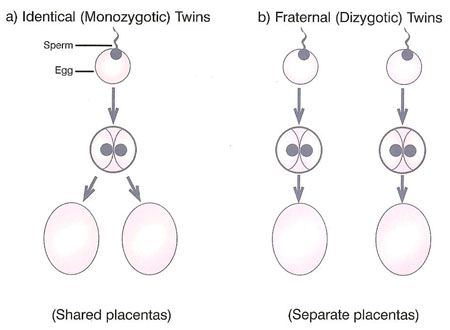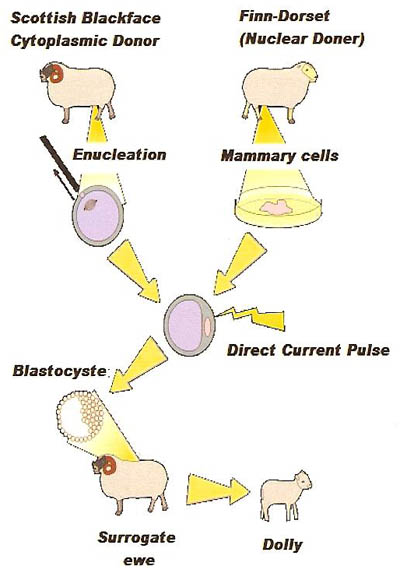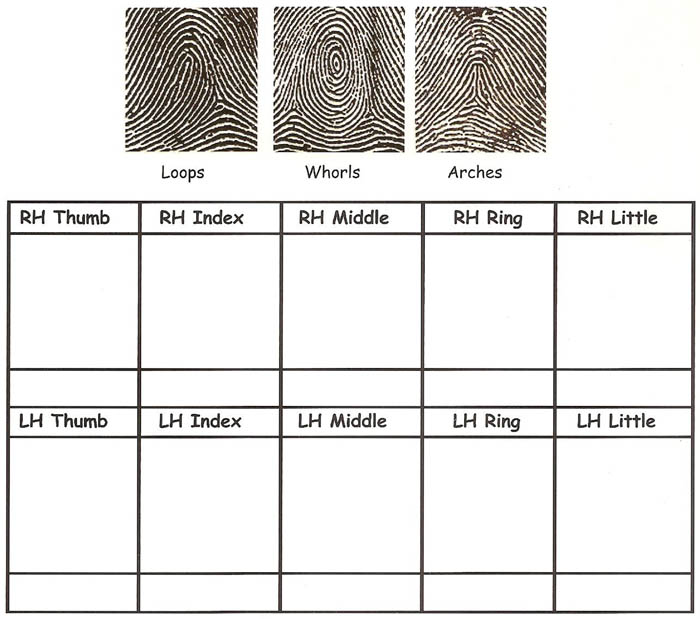IT'S IN YOUR GENES: DOES IDENTICAL DNA MAKE IDENTICAL PEOPLE?

Figure 1. Types of twins

Figure 2. How Dolly the sheep was cloned.

Figure 3. Taking fingerprints.

Figure 4. Savior sibling ballot sheet.

Are Identical Twins Nature's Clones?
TWINS are offspring that result from the same pregnancy. They can be either monozygotic or dizygotic.
Monozygotic twins are often referred to as identical twins. They occur when a single sperm fertilizes a single egg. Later, this zygote (a fertilized egg) divides to form two separate but genetically identical embryos. Monozygotic twins are always of the same sex and share almost 100% of their genes.
Dizygotic twins are formed when the mother releases two distinct eggs and each is fertilized by a separate sperm. The twins can be either the same or opposite sex. They share only up to 50% of their genes, and so are as similar as any two siblings would be.
Conjoined twins are twins joined together by some region of their bodies. There are different theories behind how conjoined twins are formed, but the most accepted one suggests that conjoined twins are monozygotic twins that do not fully separate during the splitting process (see Figure 1).
| Point for discussion
Do twins have separate identities, even if their bodies are joined? |
The Clone Zone
Unlike sexual reproduction, which combines the genetic material of two individuals, cloning involves creating an identical copy of an organism or individual by copying its genetic material. It's a bit like having your own identical twin, but one who is much younger than you. There are two types of cloning:
REPRODUCTIVE CLONING is when an individual is created who is identical to someone else. The process starts with the nucleus of a cell being extracted from the animal to be cloned. This nucleus contains all of the animal's genetic information. It is then inserted into an enucleated egg (a sex cell which has its own nucleus removed). An electrical current is passed through the nucleus-egg combination to stimulate fusion and cell division. Once this occurs, it is placed inside a host mother.
RESEARCH CLONING is designed to produce healthy cells that are able to replace diseased or malfunctioning cells. This type of cloning uses stem cells – cells that don't yet have a specific function, and can be obtained from an embryo that is only a few days old.
The most famous case of cloning is Dolly the sheep. After being born in 1997, she became the most famous animal in the world. Cloning Dolly had a low success rate per fertilized egg; she was born after 277 eggs were used to create 29 embryos, which only produced three lambs at birth. Only one of these survived (see Figure 2).
Since Dolly's birth, dogs, cats, rabbits, cows, chickens, and pigs have now also been cloned.
| Point for discussion CLONES ARE JUST LIKE IDENTICAL TWINS, RIGHT? Identical twins occur when after only one cell division, the cell splits into two giving two identical embryos that then continue to develop in the womb. They are natural clones, so what is the problem with artificially generating genetically identical people? |
'Savior Siblings' or 'Spare Part Babies'? YOU decide A 'savior sibling' is a brother or sister capable of donating lifesaving tissue (such as blood, bone marrow, or stem cells) to an existing child who is ill. A savior sibling has the same type of tissue and is genetically very similar to his/her sibling.
How does it work?
A woman's eggs are fertilized with a man's sperm in a petri dish in the lab. Embryos are produced. One or two cells are taken from an embryo when it is two or three days old and genetic and tissue typing tests are run. When an embryo is found that has the same type of tissue and similar genetics as the sick sibling, it is implanted into the mother's womb. Once the baby is born, stem cells are removed from the umbilical cord and stored for four to six months when a transplant to the sick child can take place.
An example of why this process might be used
Thalassemia is a genetic condition that affects the red blood cells. People with thalassemia have very vulnerable red blood cells that die easily. In order to cope with this disease, regular blood transfusions are needed. In this situation, the savior sibling is used to provide the blood required for transfusion.
Why might this be a problem?
Many people think that this process is wrong because it creates "designer babies" who are only created to provide "spare parts" for their ill brother or sister. Is this wrong? What do YOU think?
| Points for discussion Is it right to create a child for a specific purpose? Why? Is it ethical to deny a child the choice over how his or her body is used? Could that child then be called upon to provide further spare parts against his or her will? |
Sticky Fingers
A finger print is an impression of the friction ridges from on the finger tip. These friction ridges can also be found on the soles of the feet and the palms of the hands. Friction ridges are formed during fetal development at just 24 weeks. Throughout life, friction ridge patterns do not change. Even when the skin tissue is injured the skin that grows back will have the same pattern, unless the skin is damaged down to the dermis layer.
The purpose of these ridges is to give the fingers a firmer grasp and to avoid slippage. These ridges therefore allow the fingers to grasp and pick up objects.
No two prints have ever been found to be exactly alike. Even those of identical twins are different. Finger prints are not inherited. The basic pattern (loop, whorl, or arch) may be the same in families but the minute details will differ.
Take your own prints and try to identify which general pattern you have (see Figure 3).
Bringing the News to You
Science journalists understand and interpret very detailed, technical, and sometimes jargon-laden information and make it into interesting reports that are understandable to consumers of news media. They must also write articles with a balance of fairness to both sides but also with a devotion t o the facts.
You can find interesting and up-to-date science news stories by signing up to the excellent science e-newsletter at http://www.life.org.uk/.
Read these articles critically, asking:
We also need to remember that all the information we receive through the media has been through the editing process. For example, a journalist may have an interesting story, but the amount that can be published will depend on many factors, such as the amount of other news to be reported that day.
Edit!
Find a science article that is at least 10 paragraphs long. Now imagine that you are the journalist that has written this story. Your editor tells you that another more important story has to be reported too, and now you can only used a maximum of 100 words in your article. Cut down the article to the new word limit.
Consider: What are the essential facts of the story? What is the main message that needs to be communicated?
Be the Journalist!
A commercial science company opened its door to the public yesterday, for the first time in history offering to clone pets at a prince of $10,000. Do you think that pets should be cloned? In 200 words, write a persuasive short opinion on this topic.
Further Information for Teachers
How to Use the Ballot Sheets
This activity works best as a class group activity (see Figure 4).
Hand out the savior sibling background sheet and discuss the different views the students might have on this topic: is it right to make a baby for spare parts?
Print and cut out the savior sibling ballot sheets and hand them out so everyone has one each. Instruct the students to fill in the statements on the card but not write their names on it.
When they have answered, fold the paper and pop it into a ballot box. Pull the answers at random and use them as a means for stimulating discussion about their opinions. You may wish to put their ideas on a flip chart.
Fingerprints Identification
Loops occur in about 60–70% of fingerprint patterns encountered. One or more of the ridges enters on either side of the impression, re-curves, and terminates on or in the direction of the side where the ridge or ridges entered.
Whorls are seen in about 25–35% of fingerprint patterns encountered. In a whorl, some of the ridges make a turn through at least one circuit.
Arches are found in about 5% pf the fingerprint patterns encountered. The ridges run from one side of the pattern to the other, making no backward turn.
Journalist Activity
 |
To help students plan their own scientific article, you can try the graphic organizer technique. Give them a sheet of paper to present their ideas in the following way:
Green triangle: This represents the main idea of the article, e.g., "Scientist clones humans. This is dangerous."
Yellow square: Four corners for four separate facts that support the main idea of the article.
Red circle: Opinion of the author. (Red for "stop and think")
Also On This Site
If you found this page useful, you may also wish to check out the following resource also on this web site:
